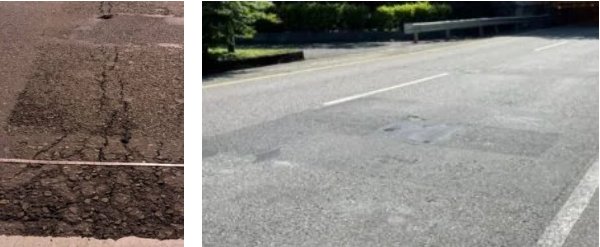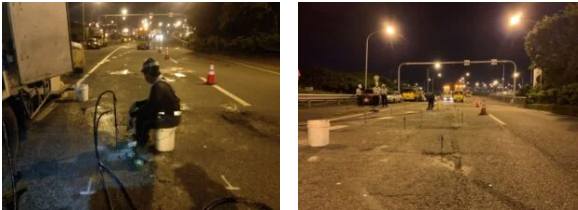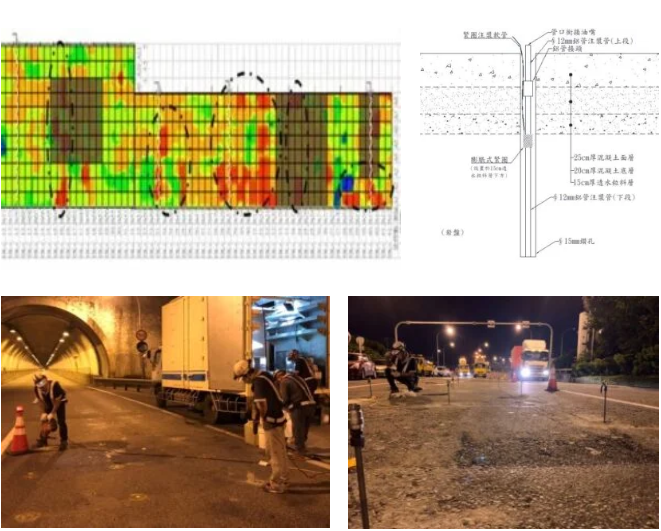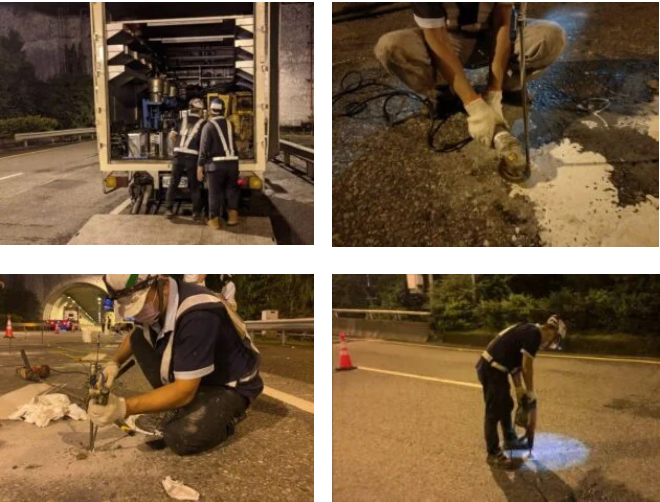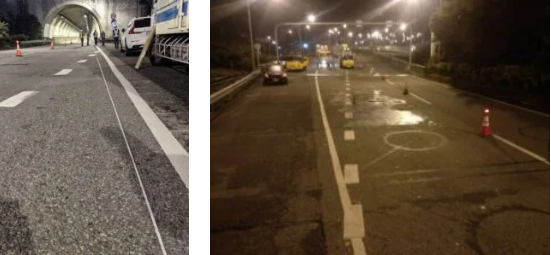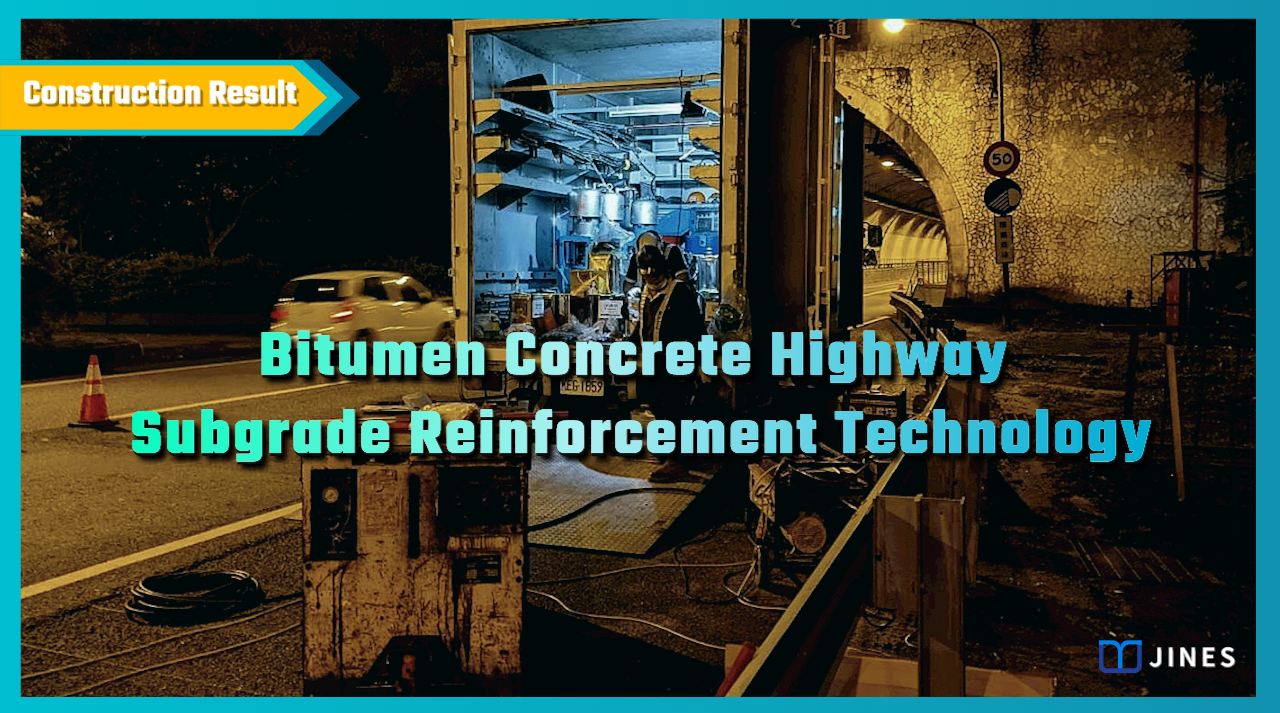
BITUMEN CONCRETE HIGHWAY SUBGRADE FILLING AND REINFORCEMENT TECHNOLOGY
Highway Interchange Road Surface Subsidence and Fracture Repair
1. Project Background
The subgrade below the pavement of a highway interchange was interbedded with sandstone blocks and sand shale, with an RQD of about 35-60%, and there were developed joints and fissures.
Both sides of this area were sloping, so the groundwater level under the pavement was high and there was a large amount of water.
The frequent traffic of heavy vehicles had caused subsidence, water accumulation, cracking and mud spray from localized cracks. The situation was becoming more and more serious.
―
2. Solution
To avoid road damage leading to driving accidents, the maintenance unit specifically sought for contractors with relevant repair experience to do roadbed reinforcement.It was also required that works be done at night and only a single lane could be closed during construction.
In response to the above requirements, the company proposed the use of micro-drilling grouting technology, with dual-liquid micro-expanding rigid polyurethane resin (Tipor-02) to fill and bond the subgrade rock fissures, and fill the hollowed-out road bed.
With the compressive strength of more than 15MPa and extrusion bonding characteristics of high-quality micro-expanding polyurethane resin after curing, it can effectively fill the subgrade holes and bond the rocky ground to increase the bearing capacity and block the groundwater seepage path.
―
3. Works Design
Because works time of this project was limited daily, the design was based on ground-penetrating radar detection results of this road section.
After analysis and calculation, the grouting holes were to be arranged in a checkerboard with a spacing of 1.4m, the single hole injection volume 60~100kg, and the grouting pressure not greater than (groundwater pressure + pipeline damping) initial value + 3.0MPa.
The grouting material is a micro-expanding rigid polyurethane resin with a curing time of about 30sec, which is squeezed into the surrounding and upper cracks from 1.0m below the pavement.
At the same time the effect of completely filling the holes and formation would be achieved. In order to prevent the grout material from escaping during grouting, the execution sequence would adopt a skip-hole method from the outside to the inside to reduce the waste of grout material and fill the gaps evenly.
During the filling process, an automatic laser level was to be used for elevation scanning throughout the process, so that the jacking of the pavement is not greater than 3mm.
―
4. Works Process
The works time could only be from 21:00 in the evening to 06:00 in the morning of the next day, so all equipment and materials had to be evacuated after the works of that day.
In order to reduce the hoisting time of the equipment, the works used a fully equipped resin grouting truck, and all equipment and materials were centrally placed on the exclusive vehicle, and the operation could be carried out after arrival at site.
Due to the limited space of the single-lane lane during works, only large hand-held electric drills could be used for drilling, and three kinds of special drills with a diameter of 15mm were used for segmented drilling to avoid excessive damage to the pavement.
When encountering underground pipelines or embedded speed sensors during works, it was necessary to apply for avoidance and supplementary holes.
Before the end of each day’s work, the drilling holes had to be filled with super-fast strengthening cement or high-strength cement, the road overflow grout should be cleaned up, and the road surface should be thoroughly cleaned, so that the road can be used immediately after the removal of traffic maintenance.
―
5. Result
This was a demonstration project, with only 91 grouting holes, which are distributed over 2 highway interchanges.
The ground-penetrating radar detection results before and after filling and the contractor’s process records show that the cracks, holes and subgrade hollows under the pavement were completely filled.
After the maintenance unit carried out pavement milling and overlay, road surface water and mud spray no longer occurred. The subsidence and fracture of the highway interchange road surface repair work had been successfully completed.
―
Bitumen Concrete Highway Subgrade Filling and Reinforcement Technology
將下載檔案寄至:
・More Construction Result Sharing
Contact us:+886 2769-2355
Copyright ©Jines Construction Co.,Ltd
